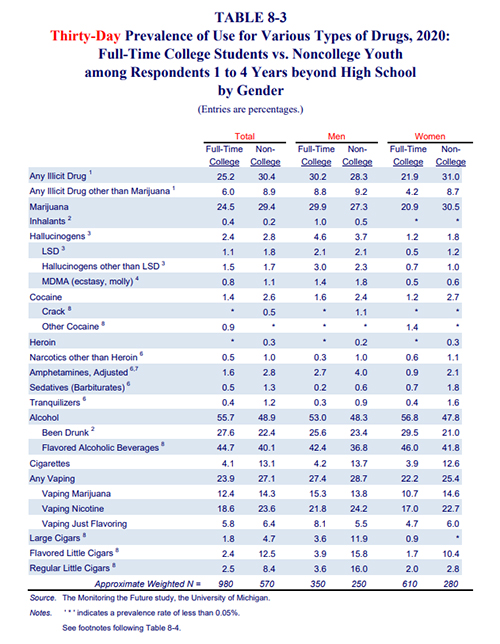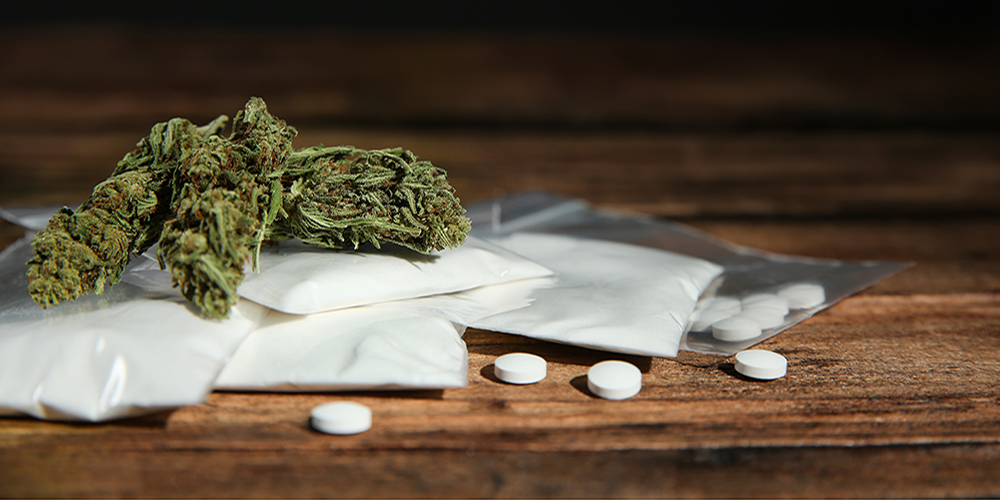Substance use among college-aged adults is shifting from alcohol to marijuana and hallucinogens, with marijuana use hitting a historic high in 2020.
Since 1980, Monitoring the Future, a publication by the University of Michigan’s Insitute for Social Research, has measured drug and alcohol use and related attitudes among college students and non-college adults ages 19-22. According to the survey’s 2020 results, marijuana use has continued to rise among college students over the past five years and has remained at historically high levels among same-aged peers who are not in college.
Last year, the survey saw the highest levels of marijuana use recorded since the 1980s. Among college students, 44% reported using marijuana in the past year compared to 38% in 2015. For young adults not in college, annual marijuana remained at 43%.
Furthermore, the use of hallucinogens significantly increased among college students between 2019 and 2020. In 2020, nearly 9% of college students reported using a hallucinogen in the past year compared to 5% in 2019.
On the contrary, the survey found marijuana and nicotine vaping slightly decreased in 2020 after showing significant increases every year since 2017 for both college students and same-aged participants who are not in college.
It also found a substantial drop in current alcohol use among college students between 2019 and 2020, with 56% of students reporting alcohol use within the past 30 days compared to 62% in 2019. Binge drinking has also seen a decline from 32% of college students in 2019 to 24% in 2020. Among non-college respondents, alcohol use has remained stable over the past five years with no drop in 2020.
“Historically, college students have reported the highest levels of binge drinking compared to same-aged youth who are not enrolled in college. This is the first year where binge drinking was similar between the two groups,” said John Schulenberg, Ph.D., professor of psychology at the University of Michigan and principal investigator of the study. “While binge drinking has been gradually declining among college students for the past few decades, this is a new historic low, which may reflect effects of the COVID-19 pandemic in terms of reduced time with college friends.”
Dr. Maria Rahmander, medical director of the substance use program at Lurie Children’s Hospital of Chicago, says these results reflect her recent experiences treating teens and young adults for substance use, reports Yahoo.com. 
“The findings here are pretty consistent with what I see clinically,” she said. “I have certainly seen an increase in patients’ reports of LSD or other psychedelic substances.”
Rahmander says the increase may be due in part to the fact that some psychedelics and hallucinogens are being used by researchers as a possible treatment for mental illnesses such as post-traumatic stress disorder (PTSD) and depression.
“I think a lot of people, knowing those studies going on, are assuming they’re beneficial,” she continued. “There seems to be a decrease in the perception of harm of cannabis products. Decreased perception of harm tends to go with increased use over time.”
As more states decriminalize marijuana, it is being perceived as less risky. The survey found marijuana was perceived as the least risky of illicit drugs. In 2006, 55-56% of respondents perceived regular marijuana use as dangerous. In 2020, only 19-22% of respondents said the same.
Researchers are continuing to study how the COVID-19 pandemic has impacted substance use among young adults and what can be done to address the associated concerns.
“The COVID-19 pandemic dramatically changed the way that young people interact with one another and offers us an opportunity to examine whether drug-taking behavior has shifted through these changes,” said National Institute on Drug Abuse (NIDA) Director Nora D. Volkow, M.D. “Moving forward, it will be critical to investigate how and when different substances are used among this young population, and the impact of these shifts over time.”







